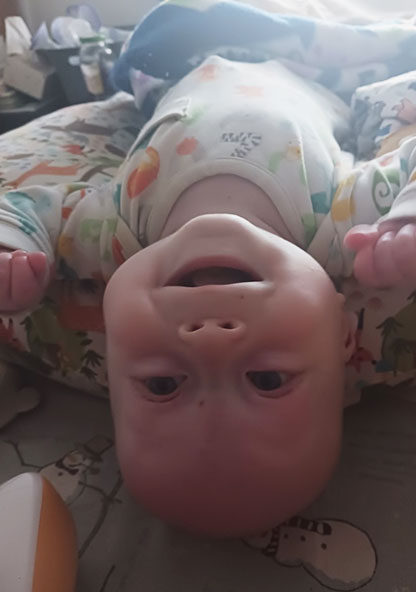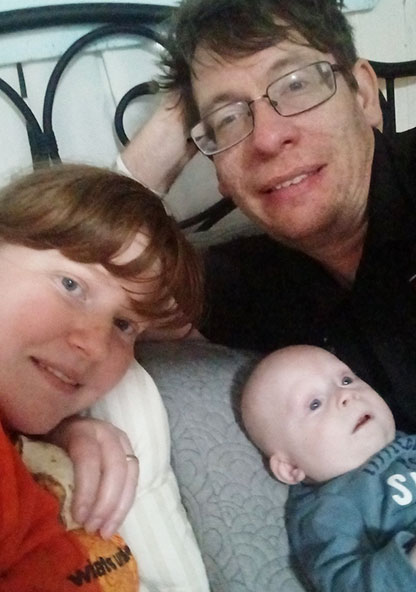A Bright Future After A Rare Diagnosis

Just starting their lives together, the newlyweds were discussing what to do with one extra room in their house. Guest room? Office? There was one alternative and Katie says it became a clear choice shortly after taking a pregnancy test: “So, I think we are turning it into a baby room,” she told her husband.
The couple was elated about the little family they were creating.
As days turned to weeks, Katie wasn’t showing much. She figured it was because this was her first baby, and she was carrying “low.” Only at her 20-week check-up did she first have any indication something might be of concern. The baby was measuring in size about a week behind where it should be. “That’s not a huge deal,” she said. “So, we weren’t concerned.”
Growing Concern
But at 37 weeks, that concern grew. The baby wasn’t showing as much movement as doctors expected.
Katie and her husband went to their usual family game night on Saturday, but she couldn’t shake the feeling that something wasn’t right. She’d texted her midwife who suggested eating sweets or even drinking a cold root beer as a way to get movement from the baby. She tried, but that elicited no response. The midwife suggested if she was worried, she should go to the hospital.
Katie later said, “I didn’t want to alarm anyone.”
Hospital Visit Turned to Emergency Delivery
Looking back, she remembers something didn’t feel quite right. To be safe, she and her husband decided to head to a hospital near their home in Schertz, TX.
“I was really hopeful that it was just time for him to be born and the reason he wasn't moving as much was that he was settling down and getting ready to be born,” she said.
Upon arrival at the hospital, doctors began monitoring Katie and the baby. They watched as his heart rate plummeted. It returned but dropped again. Katie remembers a momentary feeling of devastation. After everything they had been through, would she lose the baby?
“That was terrifying. I wasn’t sure if I was going to leave the hospital with my baby,” she said.
Doctors quickly explained their options: induction or a C-section. They chose the latter, in the interest of time.
“That gave him the greatest chance of coming out alive,” Katie said.
From there, she says things moved fast. The C-section seemed like a blur. She remembers a feeling of relief combined with a hint of guilt.
“I remember feeling really sad at that moment. I really felt like my body had failed him. He should have been safe. There shouldn’t have been a need for him to come out right then.”
William* was born on October 16, 2022, weighing three pounds, 13 ounces.
Diagnoses
Only then did Katie and her husband find out there were true complications with their newborn baby’s health. He suffered from intrauterine growth restriction, meaning he didn’t grow to the size or weight expected.
More seriously, however, he also was diagnosed with an anorectal malformation, a congenital birth defect in which the anus and rectum (the lower end of the digestive tract) don't develop properly. This occurs in an estimated one in 4,000 births and can range from mild to complex cases.
“That did scare me. I was afraid that he was going to die, and it was going to be painful,” Katie said.
She began researching anorectal malformation and joining social media groups for support.
“I was surprised at how many people were commenting. ‘Oh yeah, my brother has this,’ or ‘I actually have this.’ It was really nice to know I wasn’t alone,” she said. She was comforted by the fact that others had endured this and had survived to live fulfilling lives.
Transfer to CHRISTUS Children's
Within 12 hours of birth and because of the complexity of the procedure, Katie, her husband, and doctors decided to transfer William to CHRISTUS Children’s Level IV Neonatal Intensive Care Unit. The highly specialized and experienced team of doctors and nurses care for babies who are born prematurely, have low birth weights, or have serious medical conditions.
“I told my husband to go with him and I told him not to worry about me, that his job was to take care of the baby,” Katie said. William was flown by helicopter to CHRISTUS Children’s where he was immediately placed in the NICU.
Things were touch-and-go at first. William’s kidneys were not working in the beginning. There was discussion over whether he would need dialysis, however, he was too small. At first, his bladder wasn’t working as it should either. His medical team included Dr. Cheryl Motta, Dr. Sowmya Mohan, and nephrologist, Dr. Oluwadamilola Ejike . They worked together to decide how best to treat William. Through all of this, his doctors developed a plan of action to safely deliver nutrients to William until his anorectal malformation could be addressed.
At first, he received nutrients (carbohydrates, proteins, and fats) through an IV. He then underwent a diverting colostomy and placement of a gastrostomy tube (G-tube).
These procedures allowed William to have the time he needed to grow, develop, and heal. He was in the NICU for 86 days. Once William was feeding properly and mom and dad were trained in the proper care of the G-tube, he was discharged.
A Bright Future

“By the time we got home, we were worn out but relieved,” Katie said. But she knew it would not be their last hospital visit. Doctors said surgery would be required to correct the anorectal malformation.
When William was 5 months old, he was readmitted to the hospital for the first of two reconstructive surgeries called posterior sagittal anorectoplasty (PSARP). In these operations, an anal opening is created and then the baby’s rectum is repositioned in the correct location.
“I'm hopeful that he'll be able to be as normal of a little boy as he can be,” Katie said.
As William continues his journey, Katie is optimistic about his prognosis.
“I'm so grateful that we have the medicine and technology we do. If we didn't, I wouldn't have my baby,” she said. “Everyone at CHRISTUS Children’s was great! The NICU staff was the best.”
Katie is hopeful this procedure and the treatment William has received will give him the bright future he deserves.
*The name William is a pseudonym, used at the request of the baby’s parents.
